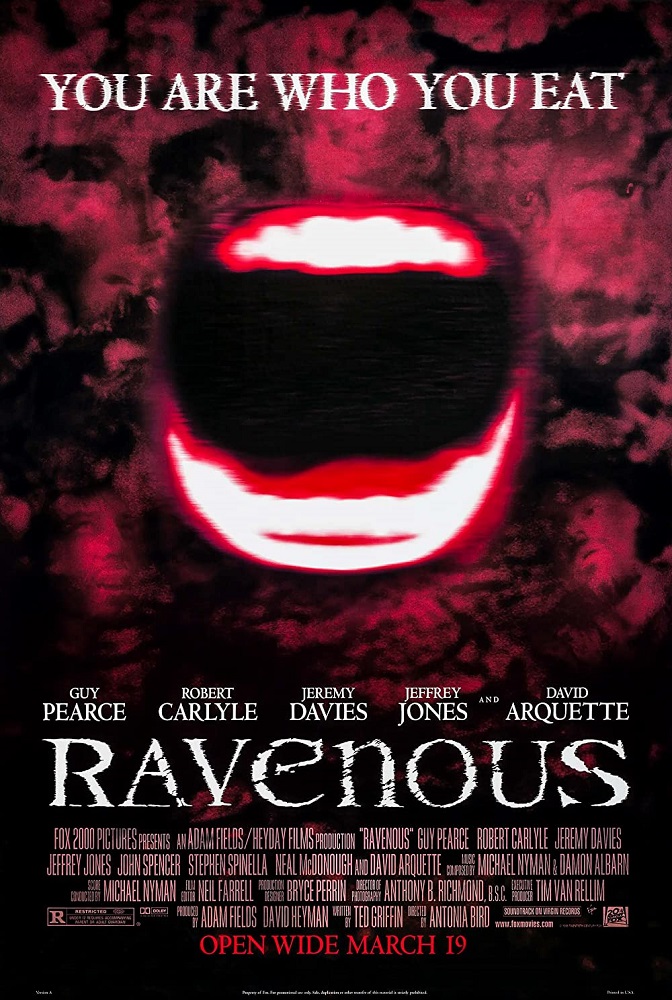Crew
Director – Antonia Bird, Screenplay – Ted Griffin, Producers – Adam Field & David Heyman, Photography – Anthony B. Richmond, Music – Damon Albarn & Michael Nyman, Digital Effects – Peerless Camera Co (Supervisor – Kent Houston), Special Effects Supervisor – Terry Glass, Prosthetic Makeup – KNB EFX, Production Design – Bryce Perrin. Production Company – Fox 2000 Pictures/Adam Fields/Heyday Films.
Cast
Guy Pearce (Captain John Boyd), Robert Carlyle (Colquhon/Colonel Ives), Jeffrey Jones (Colonel Hart), Neil McDonough (Private Reich), Stephen Spinella (Major Knox), Jeremy Davies (Toffler), David Arquette (Cleaves), John Spencer (General Slauson), Sheila Tousey (Martha)
Plot
It is 1847 during the Mexican-American war. John Boyd is promoted to captain for having captured a Mexican post single-handedly but at the same time is held in disgrace because he survived a battlefield massacre by taking the cowardly option of pretending to be dead. For this, he is posted to remote Fort Spencer in the Western Sierra Nevadas, which is manned by a group of alcoholics, drug addicts and social rejects. Shortly after Boyd arrives, so does the Scotsman Colquohon who tells a horrifying story of how he is the only survivor of a wagon train disaster where the trekkers were forced to seek shelter in a cave over the winter and how under the depraved Captain Ives the men took to killing and eating one another. An expedition is mounted to check out the cave but when they arrive, they realise that Colquhon was the real killer. Colquhon now turns and attacks the rest of the party. Boyd flees and falls into a crevasse, breaking his leg and is only able to survive by eating the flesh of a corpse. He returns to Fort Spencer to find that Colquhon is now the new commanding officer Colonel Ives. Boyd is caught between stopping Colquhon/Ives as he starts killing off the others at the fort or surrendering to Colquhon and no longer resisting his own desire to eat more human flesh.
Ravenous emerged in 1999 following a number of reported production woes – the first two directors having been dumped – and despite one of the most off-putting trailers in recent years – one that gave the impression of a studio trying to market a serious historical film about cannibalism as something funny and ending up with a horribly giggly mess that suggested neither. One had the vain hope that the problems were just in the studio-marketing department’s small-mindedness and their lack of certainty of approach. Unfortunately, the same uncertainty about what sort of film is being made extends to the production itself.
Director Antonia Bird was brought in at last minute on the advice of star Robert Carlyle. One would like to think that the choice of director was due to Bird’s aptitude and grasp of the material rather than the desperation move of being the only available director. Alas, Antonia Bird’s previous experience had been on British tv and with human drama stories like Priest (1994) and Mad Love (1995), not with historical drama or horror and she betrays a lack of feel for the genre, not to mention any clear notion of what tone to take.
There is a dreadful sinking feeling that sets in from the opening title card, which quotes from Nietzsche “He that fights with a monster should watch that he does not become a monster,” and then follows it up with “Eat Me” attributed to Anonymous. The film improves little throughout. The climax with the two antagonists fighting and impaling one another on everything from swords to knives, pitchforks, meat cleavers and finally bear traps gets amazingly silly. It might have worked in a patently B movie or in the unreal confines of the action genre, but in a serious historical drama the effect is fatuous. Bird has clearly instructed both Robert Carlyle and Jeffrey Jones to play as broadly as possible and the tone offsets many of what might be otherwise serious scenes such as Jones’s return from the dead.
Ravenous is also graced with one of the most bizarre scores one has seen in an A-budget film in some time. The two composers seem to have attempted to try to write it using as many different instruments as possible throughout, everything from pianos, electric guitar, full orchestra, bells, bugle and bluegrass guitar, these often being quite eccentrically and atonally matched together. Needless to say, the effect is distracting bordering on ludicrous – some scenes such as the entry into the cave or with Robert Carlyle murdering the investigating party and pursuing Guy Pearce through the woods rob what might otherwise be competently directed scenes of suspense with this laughably inapt score. (Apparently, the entire score was performed by people who had no musical training too).

Antonia Bird lacks a grasp of directing horror. It seems telling of the misguidedness of approach that in a film about cannibalism that we never actually see anybody devouring human flesh. There is much to the film – suspenseful plot twists, the hero’s story being greeted by official disbelief, a hero hung between surrender to impulse and moral restraint, a sustained psychological showdown between the hero and the villain – that have the making of a good movie by anybody who has a grasp of how to milk this sort of material. Unfortunately, good horror directing is something that eludes Antonia Bird – her idea of horror is caught between campy overacting or else silly shock effects like having Robert Carlyle snap a book shut loudly while sitting at the fireside.
There is a potentially good script beneath the film. In the hands of a decent director, some scenes like Jeffrey Jones’s return from the dead and the discovery that Robert Carlyle is the cannibal in the wagon train massacre and later the new colonel could have been milked for much impact. There is one well written scene where Robert Carlyle points out his grand scheme of desiring to devour the flesh of the great American westward pilgrimage and we see a looming metaphor of something that is eating beneath the concept of Manifest Destiny but the idea is subsequently dropped.
There are a number of other scenes where one wishes the script had clarified more. Guy Pearce starts to believe in the concept of the wendigo but the film never explores whether this is real or merely his delusion. And there are other questions – why it is that people enjoy eating human flesh so much and how do they gain an insatiable hunger for it; or even who Robert Carlyle’s character is – Colquhon or Ives? – and if the former (as after all, we do see Ives’s uniform among the remains in the cave) how a Scotsman then manages to become a colonel in the US Army.
There was a fad in Italy during the late 1970s/mid-1980s for cannibal movies – films like Slave of the Cannibal God/Prisoner of the Cannibal God (1978), Cannibal Apocalypse (1980) and the notorious likes of Cannibal Holocaust (1979) and Cannibal Ferox (1981). Despite being made on a tenth the budget of Ravenous and suffering from bad dubbing, bad scripting and bad acting, they have a gruelling, full-on gutsiness that, despite their lack of sophistication, hits everywhere that Ravenous in its laughably tame obsession with experimental scores, campy overacting and jokey tone, misses by miles.


